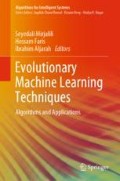Abstract
This section first provides an overview of the machine learning field in artificial intelligence (AI). The most well-regarded classes of methods in AI are discussed to show where AI optimization algorithms and machine learning techniques fit in. Different types of learning are briefly covered as well including supervised, unsupervised, and reinforcement techniques. The last part of this chapter includes discussions on evolutionary machine learning, which is the focus of this book.
Access this chapter
Tax calculation will be finalised at checkout
Purchases are for personal use only
References
Selman B, Gomes CP (2006) Hill‐climbing Search, Encyclopedia of cognitive science
Van Laarhoven PJ, Aarts EH (1987) Simulated annealing. In: Simulated annealing: theory and applications. Springer, Heidelberg, pp 7–15
Holland JH (1992) Genetic algorithms. Sci Am 267:66–73
Dorigo M, Di Caro G (1999) Ant colony optimization: a new meta-heuristic. In: Proceedings of the 1999 congress on evolutionary computation-CEC99 (Cat. No. 99TH8406), pp 1470–1477
Wang L (2005) Support vector machines: theory and applications, vol 177: Springer Science & Business Media
Breiman L (2001) Random forests. Mach Learn 45:5–32
Zhang GP (2000) Neural networks for classification: a survey. IEEE Trans Syst Man Cybern Part C (Appl Rev) 30:451–462
Ding C, He X (2004) K-means clustering via principal component analysis. In: Proceedings of the twenty-first international conference on Machine learning, p 29
Ultsch A (1993) Self-organizing neural networks for visualisation and classification. In: Information and classification. Springer, Heidelberg, pp 307–313
Watkins CJ, Dayan P (1992) Q-learning. Mach Learn 8:279–292
Sorokin I, Seleznev A, Pavlov M, Fedorov A, Ignateva A (2015) Deep attention recurrent Q-network. arXiv preprint arXiv:1512.01693
Barth-Maron G, Hoffman MW, Budden D, Dabney W, Horgan D, Muldal A et al (2018) Distributed distributional deterministic policy gradients. arXiv preprint arXiv:1804.08617
Hirose Y, Yamashita K, Hijiya S (1991) Back-propagation algorithm which varies the number of hidden units. Neural Netw 4:61–66
Author information
Authors and Affiliations
Corresponding author
Editor information
Editors and Affiliations
Rights and permissions
Copyright information
© 2020 Springer Nature Singapore Pte Ltd.
About this chapter
Cite this chapter
Mirjalili, S., Faris, H., Aljarah, I. (2020). Introduction to Evolutionary Machine Learning Techniques. In: Mirjalili, S., Faris, H., Aljarah, I. (eds) Evolutionary Machine Learning Techniques. Algorithms for Intelligent Systems. Springer, Singapore. https://doi.org/10.1007/978-981-32-9990-0_1
Download citation
DOI: https://doi.org/10.1007/978-981-32-9990-0_1
Published:
Publisher Name: Springer, Singapore
Print ISBN: 978-981-32-9989-4
Online ISBN: 978-981-32-9990-0
eBook Packages: Intelligent Technologies and RoboticsIntelligent Technologies and Robotics (R0)

